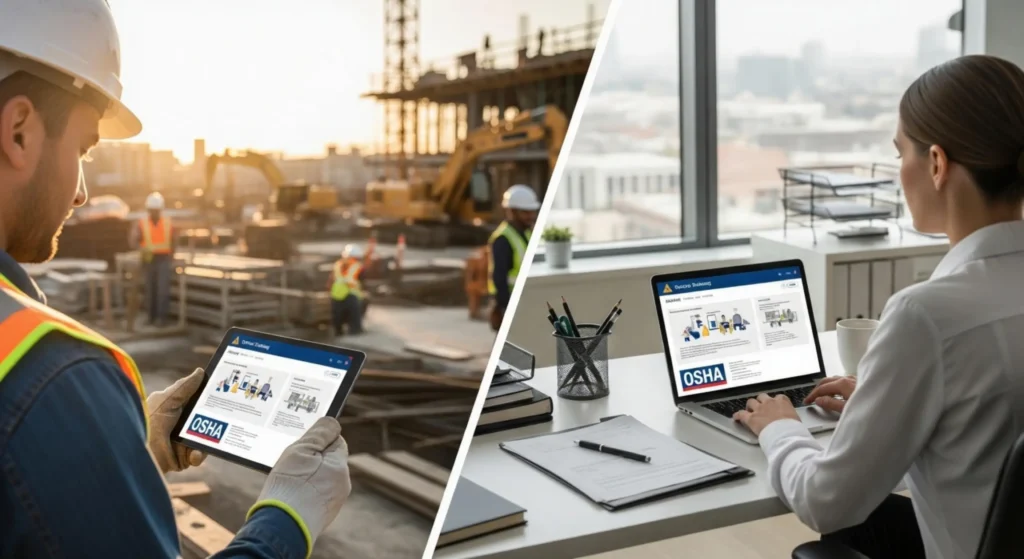Top Technologies Transforming Workplace Safety in 2025
Workplace safety in 2025 is being redefined by rapid advancements in technology. From predictive analytics to wearable sensors, modern tools are turning safety management into a proactive, data-driven process rather than a reactive one.
Organizations are now focusing on preventing accidents before they occur through continuous monitoring and real-time insights. These innovations not only reduce risks but also improve overall efficiency and worker well-being.
In this blog, you can explore the key technologies revolutionizing workplace safety and shaping the future of safer, smarter work environments.
Wearable Safety Devices and Smart PPE
The era of purely passive PPE is being rapidly replaced by smart wearable safety devices that actively monitor worker health and site conditions in real-time.
According to a 2025 market report, the global construction wearable technology market was estimated to be worth US$4.4 billion in 2024 and is projected to reach US$7.3 billion by 2030.
Moreover, smart helmets, vests, wristbands, and even smart boots are increasingly equipped with sensors to track vital signs, detect fatigue, monitor environmental hazards like toxic gases or high temperatures, and transmit alerts immediately to supervisors.
For example, one study found that among large construction firms, 55% of firms had implemented biometric sensors and 30% smart helmets, with 70% reporting a measurable drop in injuries.
These devices support a shift from reactive to proactive safety management. When a wearable detects an elevated heart rate, unusual posture, or entry into a hazardous zone, it sends a real-time alert allowing supervisors to intervene before an incident escalates.
One case study of smart helmet deployment showed a 32% reduction in recordable incidents and a 45% drop in unauthorized zone entries within six months.
The data-driven nature of smart PPE not only protects workers but also offers firms a clearer picture of safety risks, enabling them to identify patterns, refine processes, and reduce both accident rates and liability.
AI-Powered Predictive Analytics
Artificial intelligence is transforming workplace safety by analyzing real-time data to predict and prevent accidents before they happen. AI systems detect unsafe patterns, like equipment misuse, fatigue, or high-risk areas, and alert teams instantly.
According to Deloitte (2023), companies using predictive analytics have seen up to a 40% drop in workplace injuries and a 25% decrease in near-miss incidents. The AI in safety market, valued at around $7.8 billion by 2028 (MarketsandMarkets, 2024), is rapidly growing across construction, manufacturing, and energy sectors.
By automating incident reporting and providing early hazard detection, AI is shifting safety management from reactive responses to proactive prevention, helping organizations protect workers more effectively in 2025.
Internet of Things (IoT) and Connected Worksites
IoT technology is creating intelligent, connected worksites where sensors, beacons, and smart tools continuously monitor safety conditions.
Equipment now transmits real-time data on temperature, vibration, and air quality, allowing early detection of hazards like gas leaks or overheating machinery.
Geofencing technology alerts supervisors when workers enter restricted zones, while connected wearables track movement and proximity to dangerous equipment.
According to Gartner (2024), IoT-enabled safety systems can reduce workplace accidents by up to 30% and improve emergency response times by 40%.
These smart environments make workplaces more adaptive, efficient, and secure in 2025.
Drones and Robotics for Inspection and Hazard Reduction
Drones and autonomous robots are transforming workplace safety by taking on high-risk inspection and operational tasks.
Drones can access confined spaces, tall structures, or hazardous zones, such as oil rigs, construction sites, and power plants, without exposing workers to danger.
Meanwhile, robots handle repetitive or dangerous duties like heavy lifting, welding, or chemical handling with precision and zero fatigue.
A 2025 report by the International Federation of Robotics shows that robotics-driven safety programs have reduced inspection-related injuries by up to 65% in industrial environments, marking a major leap toward zero-incident work sites.
Virtual Reality (VR) and Augmented Reality (AR) Training
VR and AR are revolutionizing safety training by immersing workers in realistic, risk-free simulations of hazardous scenarios.
These technologies improve retention by up to 75% compared to traditional training, according to a 2024 PwC study.
Workers can practice emergency responses, equipment handling, and hazard recognition in multilingual and customizable environments, making safety education more engaging, accessible, and effective across global teams.
Data Integration and Cloud-Based Safety Management Systems
Cloud-based safety platforms now centralize all incident reports, compliance data, and performance analytics in real time.
A 2025 Deloitte survey found that companies using integrated cloud safety systems cut response times to workplace incidents by 40% and improved compliance tracking accuracy by over 60%.
These systems enhance transparency, enable predictive reporting, and give management data-driven insights to prevent future hazards.
The Role of AI Chatbots and Digital Assistants
AI-powered chatbots are transforming workplace safety communication by giving employees instant access to critical information.
Integrated with Environment, Health, and Safety (EHS) platforms, these assistants help workers report hazards, access training modules, and retrieve compliance data in seconds.
According to a 2025 SafetyTech report, organizations using AI assistants saw a 30% reduction in reporting delays and higher employee engagement in safety programs, bridging the gap between data systems and on-ground workers.
Future Outlook: A Safer, Smarter Workplace
As technology continues to evolve, the future of workplace safety lies in combining innovation with human oversight. AI, IoT, robotics, and immersive training tools will keep pushing safety standards higher, but their true potential depends on how organizations adopt, train, and adapt.
The workplaces of tomorrow will not only react to risks but anticipate and eliminate them proactively, setting a new benchmark for global occupational safety.
Wrap Up
The year 2025 marks a defining shift in workplace safety, one driven by technology, data, and intelligent automation.
From AI-powered analytics and IoT-connected worksites to VR training and smart PPE, safety is evolving from a compliance requirement into a culture of prevention.
These tools empower employers to predict risks before they occur and enable workers to respond more effectively.
As innovation continues, the key to sustaining progress lies in continuous adoption, workforce education, and ethical use of technology, ensuring that every advancement contributes to a safer, smarter, and more human-centered workplace.
Related Posts

Workplace Safety Survey: What 500 U.S. Workers Revealed

Top Technologies Transforming Workplace Safety in 2025


